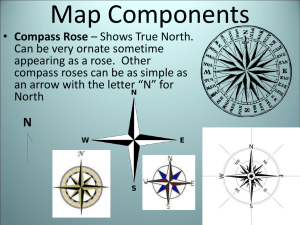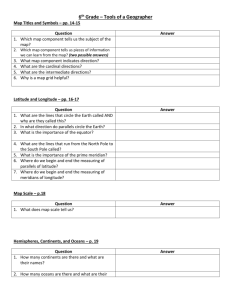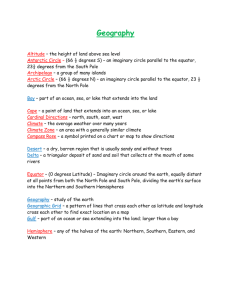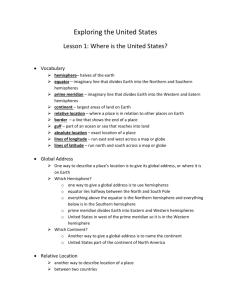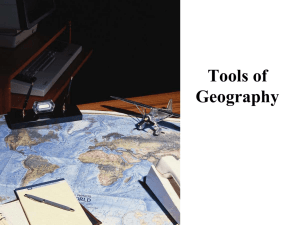1.7 Terminology Unit 5
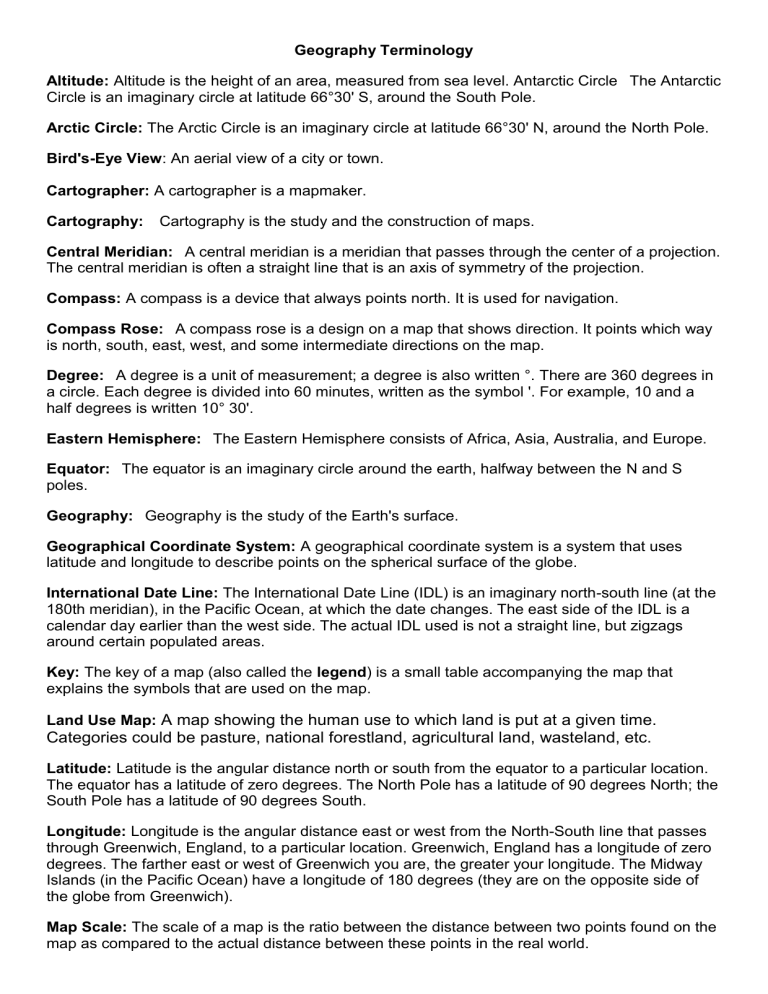
Geography Terminology
Altitude: Altitude is the height of an area, measured from sea level. Antarctic Circle The Antarctic
Circle is an imaginary circle at latitude 66°30' S, around the South Pole.
Arctic Circle:
The Arctic Circle is an imaginary circle at latitude 66°30' N, around the North Pole.
Bird's-Eye View : An aerial view of a city or town.
Cartographer: A cartographer is a mapmaker.
Cartography: Cartography is the study and the construction of maps.
Central Meridian: A central meridian is a meridian that passes through the center of a projection.
The central meridian is often a straight line that is an axis of symmetry of the projection.
Compass: A compass is a device that always points north. It is used for navigation.
Compass Rose: A compass rose is a design on a map that shows direction. It points which way is north, south, east, west, and some intermediate directions on the map.
Degree: A degree is a unit of measurement; a degree is also written °. There are 360 degrees in a circle. Each degree is divided into 60 minutes, written as the symbol '. For example, 10 and a half degrees is written 10° 30'.
Eastern Hemisphere: The Eastern Hemisphere consists of Africa, Asia, Australia, and Europe.
Equator: The equator is an imaginary circle around the earth, halfway between the N and S poles.
Geography: Geography is the study of the Earth's surface.
Geographical Coordinate System: A geographical coordinate system is a system that uses latitude and longitude to describe points on the spherical surface of the globe.
International Date Line: The International Date Line (IDL) is an imaginary north-south line (at the
180th meridian), in the Pacific Ocean, at which the date changes. The east side of the IDL is a calendar day earlier than the west side. The actual IDL used is not a straight line, but zigzags around certain populated areas.
Key: The key of a map (also called the legend ) is a small table accompanying the map that explains the symbols that are used on the map.
Land Use Map:
A map showing the human use to which land is put at a given time.
Categories could be pasture, national forestland, agricultural land, wasteland, etc.
Latitude: Latitude is the angular distance north or south from the equator to a particular location.
The equator has a latitude of zero degrees. The North Pole has a latitude of 90 degrees North; the
South Pole has a latitude of 90 degrees South.
Longitude: Longitude is the angular distance east or west from the North-South line that passes through Greenwich, England, to a particular location. Greenwich, England has a longitude of zero degrees. The farther east or west of Greenwich you are, the greater your longitude. The Midway
Islands (in the Pacific Ocean) have a longitude of 180 degrees (they are on the opposite side of the globe from Greenwich).
Map Scale: The scale of a map is the ratio between the distance between two points found on the map as compared to the actual distance between these points in the real world.
Mercator Projection : Designed to solve problems of navigation by putting longitude and latitude in the form of a grid.
Meridian: A meridian is a circular arc (a great circle) of longitude that meets at the north and south poles and connects all places of the same longitude. The prime meridian (0 degrees longitude) passes through Greenwich, England.
Northern Hemisphere: The Northern Hemisphere is the half of the Earth that is north of the equator. North Magnetic Pole The North Magnetic Pole is the point on the Northern Hemisphere of the Earth toward which a compass' needle always points; at the North Magnetic Pole, a compass' needle will stand vertically. It is now located near in northern Canada (and its location changes over time).
North Pole: The North Pole is the point on the Northern Hemisphere of the Earth that is farthest north. It is 90° north of the equator.
Parallel: A parallel (of latitude) is a line on a map that represents an imaginary east-west circle drawn on the Earth in a plane parallel to the plane that contains the equator.
Political Map: A political map is a map that shows cultural features, like the political boundaries of countries, states, provinces, and cities.
Prime Meridian: The prime meridian (0 degrees longitude) is the meridian that passes through
Greenwich, England.
Quadrangle: A quadrangle is a four-sided area bounded by two lines (parallels) of latitude and two lines of longitude (meridians) on a map.
Relief Map: Is a topographic map that uses different colors or shades to indicate elevations.
Scale: The scale of a map is the ratio between the distance between two points found on the map as compared to the actual distance between these points in the real world.
Southern Hemisphere: The Southern Hemisphere is the half of the Earth south of the equator.
South Magnetic Pole: The South Magnetic Pole is the point on the Southern Hemisphere of the
Earth toward which a compass' needle always points; at the South Magnetic Pole, a compass' needle will stand vertically. It is now located just off the coast the continent of Antarctica (and its location changes over time).
South Pole: The South Pole is the point on the Southern Hemisphere of the Earth that is farthest south. It is 90° south of the equator.
Topographic Map: A topographic map is a map that represents elevations on it.
Tropic of Cancer: The Tropic of Cancer is an imaginary line of latitude at 23°30' N.
Tropic of Capricorn:
The Tropic of Capricorn is an imaginary line of latitude at 23°30' S.
Tropics: is the warm, equatorial region between the Tropic of Cancer and the Tropic of
Capricorn.
Weather Map: A weather map is a map that shows weather conditions for a time period. Weather maps show storms, fronts, temperatures, rain, snow, sleet, fog, etc.
Western Hemisphere: The W Hemisphere is another name for the Americas (or the New World).



